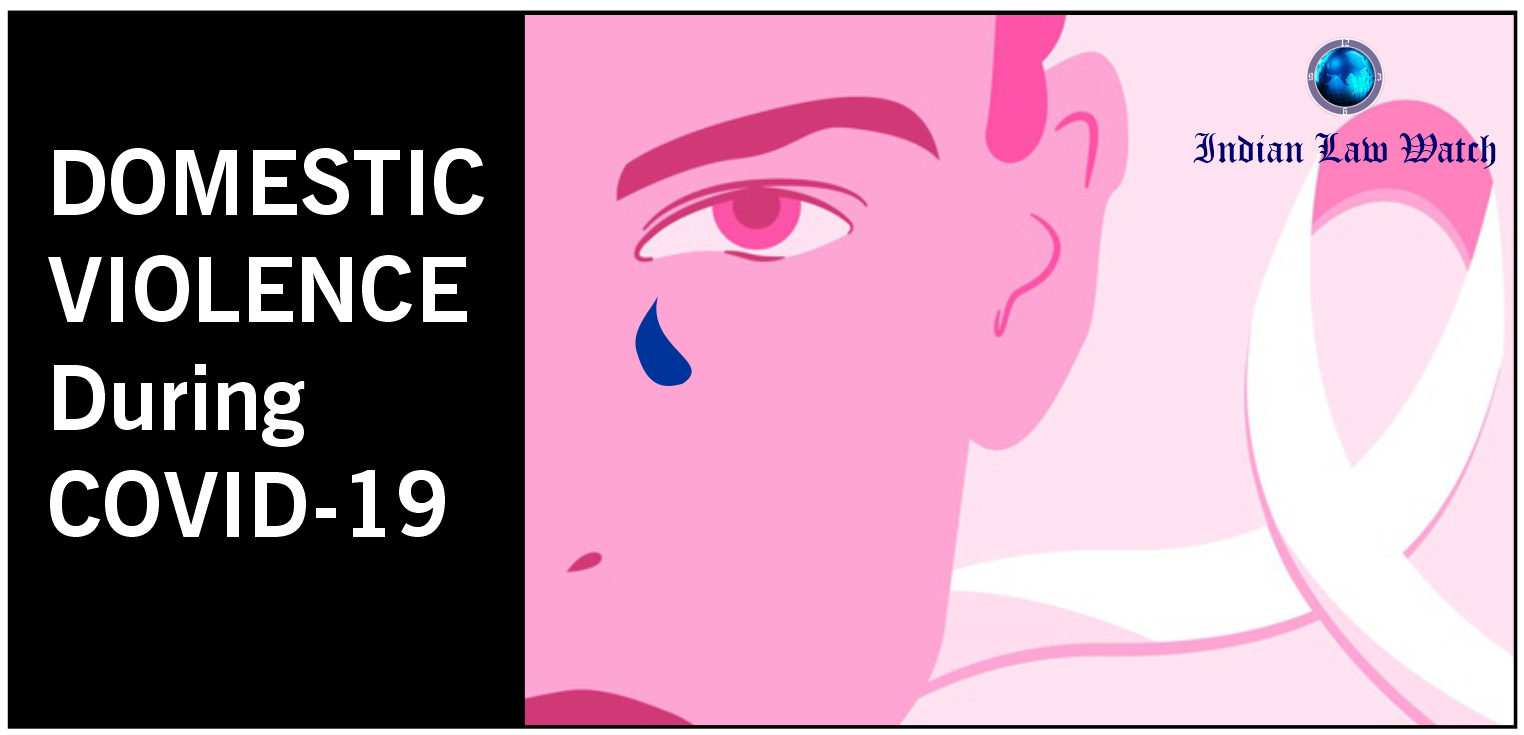INTRODUCTION
Pandemics such as the ongoing (COVID-19) have an important effect on persons, families, and countries similar. People have to deal with the outcomes of the infection as well as safety measures are taken to cover the infection such as separation, isolation, and restraint on movements. Domestic violence is gender-based violence that occurs at homes and generally involves the life partner or other family members. Due to the current pandemic and the subsequent lockdown, domestic violence has modelled the main challenge for frontline mental health professionals.
The UN Women has reported increased rates of violence against women and children during the COVID-19 pandemic. However, it is difficult to measure the point prevalence due to restrictions, both in accessing help and in reporting. Women have reported difficulty in help-seeking, while professionals have reported difficulties in assessment, service delivery, and in linking women to appropriate services. This article explores the possible mechanisms behind DV during COVID 19, its manifestations, difficulties in providing help during this pandemic, and recommendations for health professionals and mental health service providers. It also discusses the challenges in data gathering and research and provides recommendations for various stakeholders to address DV in future pandemic Domestic violence is one of the worst forms of violence because it is knowledgeable at the hands of a partner or a loved one and it degrades.
Pandemics have historically associated with different forms of violence. Sometimes, communal, sometimes against health workers, and often in the domestic sphere. DV is a type of gender-based violence that happens at homes and usually involves the spouse or partner or other family members. While the term “home” resonates with a place of safety, comfort, and warmth for many, victims of DV endure varying levels of suffering and pain at their homes. DV also includes intimate partner violence which is defined as “the behaviour of an intimate partner that causes physical, sexual, or psychological harm, including acts of physical aggression, sexual coercion, psychological abuse, and controlling behaviours.
Pandemics such as the ongoing SARS-CoV-2 (commonly referred to as COVID-19) have a significant impact on individuals, families, and countries. People have to deal with the consequences of infection as well as the precautionary measures taken to contain the infection such as isolation, social distancing, and restriction on movements. Individuals face difficulties pertaining to health care, monetary resources, and security measures, which can impact their mental health and interpersonal relationships. Restrictions on mobility further increase the risk of violence as persons in abusive relationships are trapped in their homes with the perpetrator and may have difficulties in acquiring appropriate help.
DV, particularly during this COVID-19 pandemic and the ensuing lockdown, has posed a major challenge for frontline mental health professionals. Women have reported difficulty in help-seeking, while professionals have reported difficulties in assessment, service delivery, and in linking women to appropriate services.
About three out of four women tend to experience IPV globally. The UN Women has reported increased rates of violence against women and children during the COVID-19 pandemic. However, it is difficult to measure the point prevalence due to restrictions both in accessing help and in reporting.
According to the National Family Health Survey-4, spousal violence in ever-married women in India between 15 and 49 years of age was 31.1%, which is a reduction of 6% from the findings obtained 10 years before it.[5] The most common type of spousal violence was physical violence (30%) followed by emotional violence (14%). About 4% of women reported having experienced DV during their pregnancy. Most women seek help from informal sources and family rather than the police or women’s organizations. Despite the Prevention of Domestic Violence Act is available, women often hesitate to use legal protections. This could be due to a lack of knowledge, mistrust of the police and justice systems, or poor access to legal help.
The lockdown issued for the current pandemic has worsened the situation for Indian women, and the National Commission for Women has received an increased number of DV complaints in the first four phases of the lockdown announced by the government. Such a spurt in complaints has never been documented by the NCW in the last decade. There have been suggestions that the increased number of complaints may not be due to new incidents but are rather from repeatedly abused victims. The motives for the increase or decrease in the numbers reported have not been explored yet.
Violence in home situations is likely to increase for several reasons – living with families in close confined spaces during the lockdowns can lead to conflicts as people are denied other ways of overcoming stress or monotony. Many people experience a variety of stress, but they do not respond to it with abusive behaviour. A spiritual theory posits that childhood trauma, previous personality disturbance, or substance abuse may be an explanation for why some persons resort to the perpetuation of violence. Economic helplessness during pandemics causes livelihood problems such as job losses, prolonged being without a job, reduced income, debts, and food uncertainty.
The protracted course of pandemics can lead to chronic stress, which is well known to play a significant role in causing poor mental health and psychiatric illnesses the harshly changed conditions arising out of the pandemic could trigger or worsen the existing conflicts in the house. In case there was an already-ongoing DV due to the perpetrators’ controlling behaviours, suspicion, and misogynistic attitudes, it may increase during lockdowns. The perpetrators and victims are in close contact round the clock which when coupled with social isolation could reinforce violence. Before the pandemic, women and children might have already faced general barriers, challenges, and complex decisions that might have prevented them from escaping the perpetrators safely. Such challenges to escape are amplified during a pandemic because their mobility is forced, especially due to the social-distancing measures, economic insecurities, and disrupted routines. Perpetrators may also be aware that help is not available at hand and their controlling behaviours may therefore increase.
During lockdowns, the social infrastructure is disrupted, travel restrictions are implemented, and access to technology is limited. This may lead to separation from family members or decreased contact with neighbours. In some countries, only one member is allowed to go out to buy groceries during the lockdown. As a result, women and children who are exposed to violence have lesser opportunities to go out and seek help. The perpetrators exercise their power of controlling the victims, which further reduces their access to any services.
A major concern has been that of challenges in the accessibility of services for women facing violence during the pandemic such as shelters or “One-Stop Centers” and difficulty reaching them due to lockdowns. Even if helplines are available, women may have to wait for the perpetrator to go out for a short while, to make the call. During lockdowns, it is very difficult for women to speak on their phones without raising suspicion. The possibility of reductions in hotline services, crisis centres, shelters, legal aid, and protection services makes it harder for women to reach the few sources of support that are usually accessible. Furthermore, at the time of lockdown, the accessibility to sexual and reproductive health services is also likely to be disrupted.
We know that violence manifests in different forms such as coercive control, physical abuse, emotional abuse, or sexual violence, but many a time, just physical violence gets the sole focus. Psychological violence is among the most common form of violence, and it almost always co-occurs with physical and sexual violence.
Mental violence may occur in the form of controlling behaviours such as holding back financial support; denying permission to participate in health-seeking behaviours; making them vulnerable to contracting the infection by restricting soap and hand sanitiser, or not allowing the persons to use telephones or mobiles. The perpetrators may restrict women’s access to services and reduce their opportunity to ask for help and get mental support from both formal and informal sources. They may threaten to withhold insurance cards, cancel insurance, insist on knowing where the woman is at all times, spread misinformation about the COVID-19 to control or frighten them, and prevent them from seeking medical assistance.
Health professionals may need training because many of them may not have had any education regarding the first-level response to DV. The World Health Organization (WHO) LIVES approach is an empathic and responsive method that can be used by health workers at all levels.
LIVES is a psychosocial approach formulated by the WHO that can be used as first aid for women who are facing IPV or any other forms of DV.
Globally, DV is picked up less frequently at mental health and primary care services, covering only 10%–30% of recent violence. However, the rates improve when a routine inquiry about violence is made part of mental health care. It has been found that women are more likely to open up to a health-care professional than to the police. Some of the hindrances in disclosing are fear of the consequences, fear of not being believed, fear of further violence, and feeling ashamed and discomfort with the health-care environment.
CONCLUSIONS
Women or even men with mental health problems are even more vulnerable to DV, especially during lockdowns. They are more likely to be in unsafe situations, entangled in exploitative relationships, and are more susceptible to violent victimization.
Exposure to violence in the past increases the risk of developing mental illnesses, and there is evidence to show a bidirectional causal relationship. They may not have access to treatment which may worsen symptoms, which, in turn, may increase abuse. All mental health providers need to be sensitive to the symptoms of anxiety, feelings of insecurity, and somatic symptoms as a cry for help.
Ensuring that you have some “alone time” with the woman during a consultation is important, and every woman seen should be asked sensitively about DV and helped to access services. The questions need to be framed and asked in a sensitive manner, ensuring that you are in a safe place and no friend or relative is within earshot. Women also need to know that this information will be kept confidential and you will always keep their best interest in mind.
AUTHOR IS THE WINNER OF THE COMPETITION
AYUSHI ADITYA
BA.LL.B; 3rd Semester, Maharishi Law School, Noida
CONTINUE READING
Supreme Court Guidelines for  Providing Legal Assistance to Rape Victims: Delhi Domestic Working Women’s Forum Case (1994)
Providing Legal Assistance to Rape Victims: Delhi Domestic Working Women’s Forum Case (1994)














Add Comment